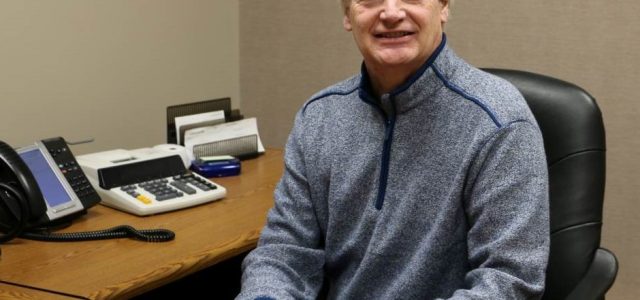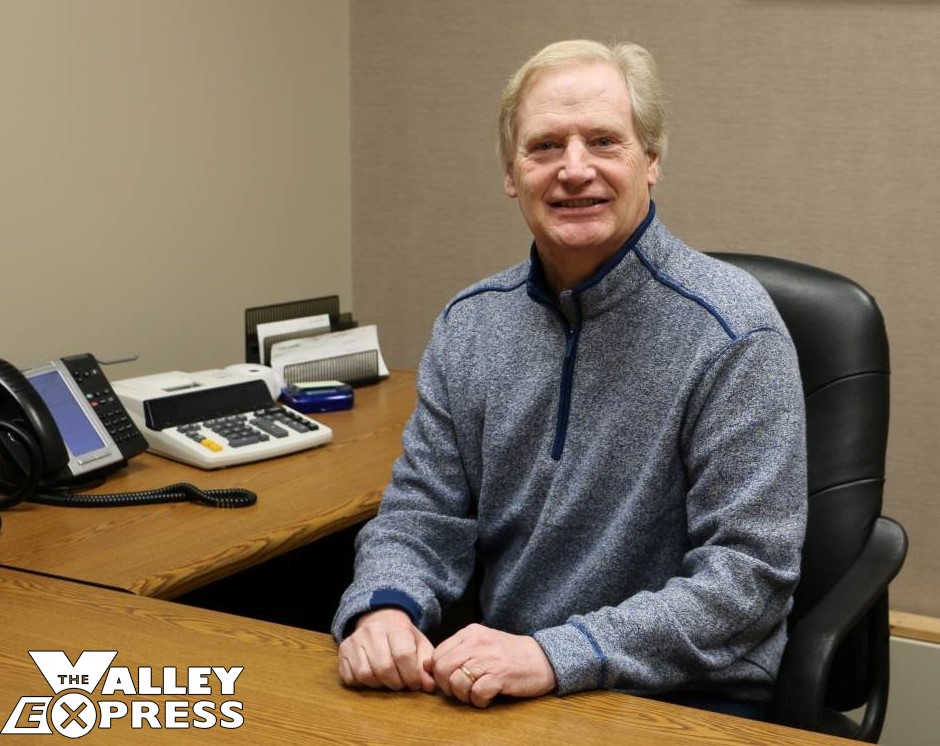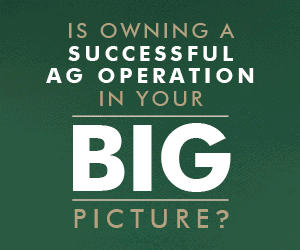Daryl Halvorson Retires from Great Western Bank After 41 Years
Local News February 1, 2022 Staff 0


It was the summer of 1980 when Daryl Halvorson moved to Milbank. Pac Man was taking the US market by storm, Airplane was showing in the theater, bread was 50 cents a loaf, and soon John Lennon would be shot and killed.
“It’s the same year I got married,” Daryl Halvorson says about his arrival in Milbank. “I came to Milbank for a job at the elevator, but it wasn’t a very good fit. So, I went to Job Service and Phyllis Hanner said, ‘Why don’t you go see Marwood Wise, the president of the bank?’”
“When I went to the bank, Marwood said he didn’t have a job, but he created a position for me to see if things would work out.” You could say that decision was right on the money because it’s now over 41 years later, and Halverson just put in his last day at Great Western Bank. Today, February 1, marks his first day of retirement.
Halvorson says, “If I took all the staff that’s here now and added up their years of service, they wouldn’t total up to my 41.5. Almost, though.” However, during his four decades at the bank, he has come to appreciate the old and the new, the experienced and the not so experienced.
When I started here, someone asked me if I knew how to run a calculator and I said ‘Yeah, I know how to run a calculator.’ The truth is I didn’t know how to do it well. But, that’s what they gave me for my first position. I had to in-code the checks, and I was terrible because I ran the calculator one finger at a time.”
“Kerry Fish worked for us then and she would come in at two o’clock. She basically did almost a whole day’s work because I had done just a little part of it. She was good! Eventually, though, I learned how to really run a calculator.”
He says he learned a million other things, too, and not just technology and office practices. “When I was a kid I worked on our farm. The bank was my first job where my dad wasn’t my boss. I wasn’t quite ready for the reality of the business world.”
In the beginning, he attempted to just fit in. “We don’t get coffee breaks anymore, he says, “ but back in the day Milbank had a place called the Gallery Restaurant and about 15 or 20 guys would sit around a big table there and drink coffee.”
“I had never had a cup of coffee in my life. But, I thought, well, you know, I got to.” They shook dice to see who paid. “I was by far the poorest and the youngest one at the table, but I ended up buying more than my share of coffee. And I kept going and buying coffee. I tried different things – cream, sugar, everything — to make it taste better, but it just never appealed to me.”
“One day I said to myself, ‘Why do I drink coffee if I don’t like it? I might as well enjoy what I’m having’. That day I ordered chocolate milk. It was funny because the next day or during that week, over half of us were drinking something other than coffee. The majority didn’t enjoy it either. They’d gone along with the group. Even though I was the youngest I realized, ‘It’s okay to be who you are.’ That was probably one of my lessons in life. Be true to yourself.”
It might also explain why he ended up in banking. “I had no idea I’d become a banker. I wanted to be a farmer, he says” (He grew up on a farm near Mellette, South Dakota.) “But, I realized my brother made a much better farmer.” He also toyed with becoming a lawyer and then discovered it wasn’t exactly like it’s portrayed on TV. He decided to get a business degree.
A business degree was perfect. “I’ve been involved in every single department in the bank, I’ve been part of consumer lending, real estate loans, and business lending along with the ag banking. I’ve been a supervisor and a manager of people.”
But he says he wasn’t really in the banking business. “I was in the people business. The people, the customers I help, plus the people I have gotten to work with over the years, that was my job. And, the best part of my job.”
Some of my greatest accomplishments were on account of my most difficult customers. When I started, I said,’ I’m not sure how I can help you.’ And then I was happiest when I found a way to help them be more successful in their life.”
“You know, you just have to learn to care about people. A lot of industries train you because they’re specialized and unique, but in banking, you’re involved in so many facets of a person’s financial life. The truth is most people struggle a little bit so it’s often about understanding the opportunities that could make life better for them.”
At least he got to do everything during bankers hours, right? Not quite. Halvorson says. “I’ve put in a lot of extra time over the years, and I’ve actually gotten calls at two in the morning about a loan.” He laughs just thinking about it, and says “They might have been sitting at a local ‘establishment’ and talking. You know. It’s late, and somebody probably said, ‘Let’s check and see if we can buy this?’”
He has zero complaints about his customers, though. “We are in such a wonderful community. People are hardworking and they’re honest. I’ve had very, very, very few loans that ever went bad.”
“The people he worked alongside were also outstanding,” he says. That number has decreased with the advancement of technology. “I don’t know the exact number, but I think at one time, including the insurance and bookkeeping departments, we employed about 30 people.
That was when the bank used to run pretty wide open. We had a teller at the back of the bank and people could come in through the back door. Everything’s about less people now. When I started, it was about a person per million and now it’s probably about a person per 20 million.”
He again attributes that to our digital world. “We used to stuff the checks in the statements and mail them out. Everything was mailed out. And we’d go through to check the checks to make sure the signatures were okay. It was a very manual process. Now, customers monitor their statements online and the information is always right there. It’s available on a daily or hourly basis, when they used to have to wait a month.”
What is the oldest machine in the bank? He laughs and points to himself.
“Technology is continuously changing. Our computers get updated constantly, and we just put in a new and different coin counter and a different currency counter.”
The bank itself has also experienced many changes. “Great Western was called Dakota State Bank when I started,” he says. I figured it out, and it has changed its name eight times. Soon it will be number nine with the merger of Great Western Bank and First Interstate Bank. I’m really excited about that.”
It seems like 1980 was just yesterday, but you turn around and suddenly 41 years have passed. Halvorson found he was no longer the greenhorn, but had become the mentor for those just starting out. How did he feel about that?
“You know, it was wonderful,” he says. “But to be honest, I learned from them too. It’s always a give and take type of thing. It wasn’t all me because they taught me a lot of things. And so I’ve been very, very blessed that way.”
“My parents instilled in me that it’s not about the money. It’s about what you can do to make the world better. I always saw them as volunteers. Now, I’m very much looking forward to expanding my volunteerism during my retirement. But, I can’t possibly give back all that I’ve received!”
He already has made a good start on it. During his busy business career, he also found time to be an officer, on the board of, or active in many civic organizations: Knights of Columbus, Kiwanis, Chamber of Commerce, the Milbank Housing and Redevelopment Commission, NESD Healthcare Foundation, the Hospital Advisory Board, Hospice, Chautauqua Concert Association, St. Lawrence and Milbank schools, and St. Lawrence Church.
At St. Lawrence Church, he also serves as one of the church organists. It’s something he also acquired from his father. “My dad did it every week. I just play one weekend a month at St. Lawrence and it’s two to three services.”
My father had never had an organ lesson, but he was the church organist because he played the piano so well. He played for over 50 years. Probably even 60 to 70. He played for the little country church that actually was on our farm.”
Halverson jokes about how playing the organ probably saved him when he was learning to run a calculator. He says he started with nine years of piano lessons. “My lesson for the organ was when my father explained to me, somehow you have to keep your fingers connected. That’s what you do differently than piano. I kind of just started playing the organ at around age 16.”
“So, I played for the little church and played for weddings and things like that. It was all a process. People were kind to let me struggle through because I was learning. Now, at our church, we have a keyboard that’s electric and can do different things and it’s fun to be learning that. I’m still learning – in banking, in life, and in music.”
Music will probably always remain an important part of his life. “I’ve been president of the Chautauqua concerts since 1996”, he explains. We bring in up to five concerts a year in partnership with Minnesota. We have concerts in Milbank and some in Ortonville. We literally get concerts from all over the world. Broadway! Russia! Europe!”
His connection to Chautauqua also was fostered at a young age. “One summer I received an International Order of the King’s Daughters and Sons scholarship. The IOKDS is an international, intergenerational, interdenominational, Christian service organization. Their headquarters are located in western New York at the Chautauqua Institution on Lake Chautauqua.
Halvorson says, “My parents drove me to Chautauqua, New York, and every night big names entertained us — Doc Severinsen, Count Basie, Mel Tillis. I got to go for free. My parents planned to come back to pick me up, but after they realized what a long drive it was, they made arrangements for me to return to South Dakota by plane. It was my first trip on an airplane.
He caught the travel bug and now he’s ready to scratch that itch a lot more. His idea of the perfect day of retirement? “Traveling with my wife. We want to explore the continental United States and then Europe. We’ve been to England and want to go back to Europe. DC is also on my bucket list because of the history. But it won’t be anytime soon. Cathy is pretty reluctant to travel. We have two elderly mothers, and she works as a nurse at the St. William’s Care Center.”
But Halvorson is not chagrined. “God has afforded me so many blessings,” he says. “My wife, Cathy, and I have been married 41 years. Our son, Adam, is married and lives in Loveland Colorado. Our daughter, Rebecca, lives in the Sioux Falls area. She’s married and they have two children.”
“I have just been so fortunate! That’s why I want to continue to give back,” he says.
“I try to keep a good attitude,” he added. “I always looked forward to coming to work because of the people I worked with – both the customers and the employees. And so, you know, work never, never seemed like a job.”











No comments so far.
Be first to leave comment below.